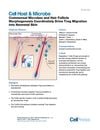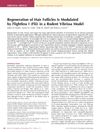TLDR Regulatory T cells help hair growth by using the Cxcr4-Cxcl12 pathway.
The study explores the role of regulatory T cells (Tregs) in hair follicle regeneration, emphasizing the Cxcr4-Cxcl12 chemokine axis. Tregs, expressing Cxcr4, accumulate in hair follicle epithelium, a process supported by glucocorticoid receptor signaling. Disruption of this axis results in suboptimal hair growth, highlighting its importance in hair regeneration. The research, conducted on genetically modified mice, shows that Cxcr4 expression is crucial for Treg accumulation near hair follicles, which supports hair growth by stimulating hair follicle stem cells. Similar expression patterns in human scalp skin suggest an evolutionarily conserved mechanism, with potential implications for alopecia treatment by enhancing Treg trafficking to hair follicles.
 21 citations
,
January 2024 in “Science Immunology”
21 citations
,
January 2024 in “Science Immunology” Regulatory T cells protect hair follicle stem cells by maintaining immune privilege in the skin.
74 citations
,
October 2023 in “Nature Reviews Molecular Cell Biology” 47 citations
,
July 2023 in “Nature Genetics”  101 citations
,
March 2019 in “Cell Stem Cell”
101 citations
,
March 2019 in “Cell Stem Cell” Certain immune cells in the skin release a protein that stops hair growth by keeping hair stem cells inactive.
 192 citations
,
March 2017 in “Cell host & microbe”
192 citations
,
March 2017 in “Cell host & microbe” Hair follicle development and microbes help regulatory T cells gather in newborn skin.
 64 citations
,
July 2016 in “Journal of Immunology”
64 citations
,
July 2016 in “Journal of Immunology” Blocking the CXCR3 receptor reduces T cell accumulation in the skin and prevents hair loss in mice.
 155 citations
,
May 2016 in “Nature communications”
155 citations
,
May 2016 in “Nature communications” Memory T cells in the skin balance staying put and moving into the blood, clustering around hair follicles, and increasing in number after infection.
245 citations
,
October 2015 in “Nature medicine” Hair follicle-derived IL-7 and IL-15 are crucial for maintaining skin-resident memory T cells and could be targeted for treating skin diseases and lymphoma.
175 citations
,
December 2014 in “PLoS Biology” Macrophages help activate hair follicle stem cells, affecting hair growth and skin repair.
286 citations
,
June 2012 in “Nature Immunology” Hair follicles help attract immune cells to the skin during stress.
503 citations
,
May 2009 in “Cell stem cell” Lrig1 marks a unique group of stem cells in mouse skin that can become different skin cell types.
 17 citations
,
December 2010 in “Journal of Investigative Dermatology”
17 citations
,
December 2010 in “Journal of Investigative Dermatology” Flightless I protein affects hair growth, with low levels delaying it and high levels increasing hair length in rodents.





